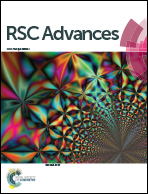Synthesis of new fused heterocyclic aromatic hydrocarbons via C–S and C–C bond formation by C–H bond activation in the presence of new Pd(ii) Schiff's base complexes†
Abstract
The Schiff's base aza-macrocyclic Pd(DPTTP)Cl2 and Pd(TPTTP)Cl2 complexes are efficient photocatalysts for the activation of the C–H bond and the formation of both intramolecular C–C bond and C–S bonds to obtain the fused heterocyclic system. Both ligands and Pd(II) complexes are well characterized by experimental and theoretical techniques such as microanalyses, mass, surface area, SEM, TGA, XPS, IR, UV-visible, 1H-NMR, DFT and TDDFT methods. C–H bond activation was confirmed by sequential reactions and the data were supported by a one-pot synthesis product. Optimization of the intensity of visible light of the photocatalytic reactions. Finally, the sp2-H bond activation via the formation of the C–S and intramolecular C–C bonds in the presence of both the complexes were performed under visible light irradiation to obtain the new fused system, pyrido[3′,2′:6,7][1,4]thiazepino[2,3-h][1,6]naphthyridine. It is also shown that the performance of the Pd(TPTTP)Cl2 is better than that of Pd(DPTT)Cl2 due to its high surface area and low bandgap energy.


 Please wait while we load your content...
Please wait while we load your content...